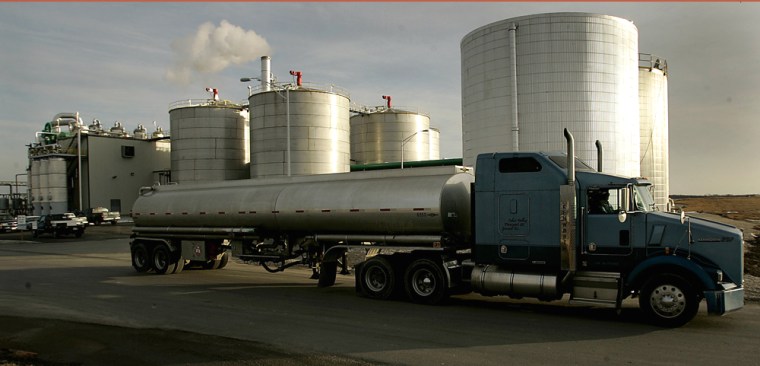The Bush administration's new energy plan to reduce gasoline demand by 20 percent could have an unintended side effect — increasing greenhouse gas emissions, California environmental officials say.
The president's plan, outlined during Tuesday's State of the Union address, would increase the amount of alternative fuel refiners must blend with gasoline and tighten vehicle fuel-efficiency standards. Bush also said the plan would help reduce greenhouse gas emissions.
But officials with Gov. Arnold Schwarzenegger's administration say the president's strategy to wean the country from its dependence on foreign oil falls short of environmental reform.
It was the latest shot at the Bush administration by the Republican governor and his administration, which has chastised the president and the previous Republican Congress for failing to act on global warming.
"We think it not only does not go far enough but may actually, in some cases, if not done right, will increase greenhouse gas emissions," California Environmental Protection Agency Secretary Linda Adams said during a news conference Wednesday. "Without a cap or some kind of a carbon standard, we think the Bush plan falls short."
Fossil fuels still used
At issue is the federal government's broad definition of alternatives. The processes used to create some of them include a number of methods that burn fossil fuels or turn coal into liquid. Such actions release the carbons that are blamed for global warming.
Producing ethanol, for example, relies heavily on the use of fossil fuels to burn corn. Once it's produced, it has to be sent by truck or rail from the Midwest to California and the East Coast, where most of the country's gasoline is consumed.
Turning coal into liquid to supplement gasoline could double the amount of greenhouse gas emissions of traditional fuel, said Robert Sawyer, chairman of the California Air Resources Board.
Those methods may reduce consumption of foreign oil but do little to address climate change in a nation that is the top producer of greenhouse gases.
"To the extent you replace gasoline with carbon-based fossil fuels in a different form, it deals with the import-dependence issue, but it probably doesn't get you anything on the environment," said Frank Verrastro, director and senior fellow of energy programs at the Center for Strategic and International Studies in Washington, D.C. "It depends what master you are serving."
The White House did not immediately return a call Wednesday from The Associated Press seeking comment.
Cellulosic ethanol favored
Although Bush focused on ethanol in his speech, the federal Environmental Protection Agency also lists cellulosic ethanol as a recognized alternative fuel. Producing that type of ethanol is favored by California officials because it can be made from homegrown products such as wood chips, sugarcane and switchgrass.
The Bush administration on Wednesday proposed spending $1.6 billion to develop new sources of ethanol.
Schwarzenegger officials said the federal government should let the market decide what alternative fuels are eventually produced and marketed. California's plan does not include any subsidies.
California already has its own strategies to reduce emissions from automobiles.
The governor last week signed an executive order mandating that California refineries reduce the carbon content of passenger vehicle fuels 10 percent by 2020. His proposal, which is pending before the Air Resources Board, does not list what fuels should be used to achieve the goal.
"We don't pick winners or losers," Adams said.
Tailpipe emissions
The other key element of Bush's plan is higher fuel-economy standards, raising the fuel efficiency of passenger cars and light trucks by an estimated 4 percent annually. But the proposal would allow for automakers to avoid meeting the new standard by making less fuel-efficient, larger vehicles, said Dan Skopec, an undersecretary with the California EPA.
California, the world's 12th-largest producer of greenhouse gases, is pushing a separate initiative to reduce greenhouse gas emissions from automobiles. Taken together, the tailpipe and clean-fuel strategies are projected to reduce emissions by 26 percent over the next 10 years, Skopec said.
The federal government, however, has not granted California the federal waiver it needs to implement its tailpipe-emission regulations. Automakers also have sued in federal court to stop them from taking effect.
